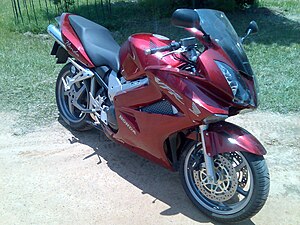Honda VFR800
 |
|
| Manufacturer | Honda |
|---|---|
| Also called | Interceptor |
| Production | since 1998 |
| Predecessor | VFR750F |
| Successor | VFR1200F |
| Class | Sport touring bike |
| Engine | 782 cc liquid-cooled 4-stroke 16-valve DOHC V4 |
| Bore / stroke | 72 mm × 48 mm (2.8 in × 1.9 in) |
| Compression ratio | 11.8:1 |
| Power | 104 hp (78 kW) @ 10,250 rpm |
| Torque | 55 ft·lb (75 N·m) @ 8,500 rpm |
| Transmission | 6-speed chain drive |
| Brakes | 2×310 mm (front) 256 mm disc (rear) |
| Wheelbase | 1,458 mm (57.4 in) |
| Dimensions |
L: 2,120 mm (83 in) W: 735 mm (28.9 in) H: 1,195 mm (47.0 in) |
| Seat height | 805 mm (31.7 in) |
| Weight | 481 lb (218 kg) US Spec (dry) 520 lb (240 kg) (wet) |
| Fuel capacity | 5.2 US gal (20 l; 4.3 imp gal) |
| Related | Crossrunner |
The Honda VFR800 is a fuel injected sport touring motorcycle first produced by Honda in 1998. It is the successor to the VFR750F and, like the earlier bike, has the V4 engine configuration shared with the Honda VF and VFR motorcycle family. The VFR800 is known in the USA as the Interceptor.
Rather than being a direct development of the previous, carbureted VFR750F engine, the VFR800 engine was a detuned and longer-stroke power plant based on the fuel-injected engine designed for the RC45 of 1994. The RVF750R RC45 engine, although a development of the VFR750R RC30 and originally derived from the VFR750F RC24, was very different from Honda's previous V-4 as the gear drive to the cams was moved from the centre of the engine to one side, similar to the CBR250. Tuned for road use in the VFR800, power was slightly increased over the VFR750, and torque was improved throughout the rev range. In 2000, Honda updated the fifth-generation VFR (RC46) with a catalytic converter, oxygen sensors, and an EFI system that would enter closed-loop mode under highway (cruising) operation.
The VFR800's frame. which uses the engine as a stressed member of the frame, was derived from the VTR1000 Firestorm, but it retains the trademark VFR single-sided swingarm pivoted from the aft of the crankcase.
The VFR800 has a novel DCBS linked braking system. This system is a departure from traditional motorcycle braking system where front and rear braking are independent of each other. In this system, the front brake lever applies pressure to four (or later, five) of the six front brake caliper pistons. The rotational movement of the left caliper when engaged actuates a secondary master cylinder and applies pressure to one of the rear caliper's pistons. The rear brake pedal is directly attached to the remaining pistons (two in the rear, and one (or two) in the front).
...
Wikipedia
